Hay for horses
Learn about the types of hay for horses.
Introduction
The horse hay market has been a stable market for many farmers for a number of years. The demand for "quality horse hay" is strong with price fluctuations depending on availability. The 1996 Ontario Horse Industry Study indicates that hay valued at $100 million is consumed by horses in Ontario annually.
Horses consume 2-2.5% of their body weight in dry matter daily. Forage in the form of hay and hay cubes will comprise 50-100% of the dry matter requirements. Therefore, a 1000 lb mature horse can be expected to consume 22-24 lb of hay daily on an as fed basis. (1000 lb x 2% or 1000 lb x .02 = 20 lb of dry matter. Hay is 90% dry matter; therefore, 20 lb of dry matter is equal to 20 x 100/90 = 22 lb of hay on an as fed basis). Assuming that a small square bale of hay weighs 50 lb, this represents about ½ a bale of hay per day per mature 1000 pound horse. (For the purposes of this article, the term "bale" refers to a 50 lb small square bale of hay. However, there is a large variation in bale weight from as low as 30 lb up to 60 lb Therefore, it is best to weigh a number of bales and get an average for your hay.)
Young horses and horses actively participating in a sport will consume at least 1% of their body weight in dry matter. The remaining nutrients will be provided from whole grain, fat and/or commercially prepared feeds.
There are 293,000 horses in the province of Ontario. Therefore, we can estimate that 150,000 bales of hay or their equivalent are consumed daily for approximately 220 feeding days per year. This equates to 33 million bales per year. Since the Ontario horse population can also be broken down by county, hay producers could estimate the horse hay market for their region. For the counties of Wellington and Waterloo with 13,533 and 16,485 horses respectively (30,000 horses in total), the horse hay market would amount to approximately 15,000 bales per day or 3.3 million bales per year based on 220 feeding days per year.
Hay and hay quality
Hay can be a composition of one or more legumes or grasses at various proportions depending on the composition of the plants in the field from which the hay was harvested. The proportions will vary from the original seeding proportions. They will depend on the success of seed germination, the age of the hay stand (years since planted), whether it is first or second cut hay, and growing conditions such as amount of rain. A first year seeding of an alfalfa/timothy mix (ratio of 70:30) may yield a 70:30 alfalfa/timothy hay in the first cut of the first year. However, in Ontario, the second cut will be almost pure alfalfa. Grasses such as timothy prefer cooler, wetter periods of the year and do not regrow until later in the summer. The proportion of alfalfa in the hay stand in subsequent years will also decrease due to winter kill and disease.
Legumes
Alfalfa hay is well accepted by horses. Because horses are selective grazers, given the opportunity, they will readily consume the leaves and push the courser stems aside. Horses are commonly seen "vacuuming" the bottom of the hay manger for the leaves. When fed on the ground, 20-25% of the nutrient value of the hay is lost into the dirt, especially when feeding alfalfa hay with its high leaf content. Alfalfa hay has to be fed with some care because of its high calcium level in relation to phosphorus (range from 5:1 to 8:1). Younger growing horses and pregnant mares should receive a balanced ration containing sufficient calcium and phosphorus and in the ratio of 1.5:1 to a maximum of 2:1. Ratios of calcium to phosphorus greater than this can cause growth and development problems such as epiphysitis.
Alfalfa is an excellent source of protein and energy. Adult horses require 10-11% crude protein in their overall diet while growing horses require 12-14%. Pure alfalfa hay, as found in second cut hay, can have protein levels up to and exceeding 18% protein. This high level of protein is not required for most horses. Excess protein from both hay and grain feed sources will be broken down into carbohydrates and serve as additional source of energy. The nitrogen radical will be excreted in the urine. This will lead to increased urination and wetter bedding. It is uncommon for horses to have a kidney problem; however, those that do might have difficulty excreting the higher levels of nitrogen as found in alfalfa hay.
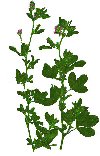
Clovers
Horses like clover and will select the highly palatable clovers from the pastures and hay. The white clovers have 1/3 less fibre content than other roughages such as bromegrass and alfalfa. White clover in its lush stage of growth could contain 22-25% crude protein on a dry matter basis. The digestible energy content of lush clover is also very high.
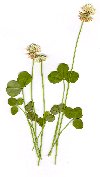
White Dutch or common white clover is a low growing plant (less than 5 inches) which grows well in pastures but is too short to harvest for hay. In a fresh state it is very high in carbohydrate content and low in fibre content. Ladino clover is a tall white clover but is easily killed by Ontario winters. Red clover is a biennial which means it will live for about two years and then will die off unless it is allowed to re-seed itself. As a hay crop, clover is hard to dry and becomes moldy. These molds can contain estrogenic properties which can interfere with the reproductive cycles of mares.
Clovers are particularly useful because they can be used to improve pastures and hay fields by frost seeding. The clovers, however, can also produce slaframine which is known as the "slobber factor." Slaframine will make horses salivate profusely. This is commonly seen in some parts of North America. Red clover has also been associated with red urine in some horses. Porphyrins are excreted into the urine and will oxidize and turn red. This is usually seen during the winter when horses urinate on the snow.
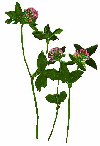
Alsike clover must be differentiated from the other clovers because it can cause photosensitivity and hepatic failure in horses. Horse pastures and hay fields should not contain alsike clover.
Birdsfoot trefoil
Trefoil is a perennial which can spread throughout pastures and hay fields, increasing each year. It is promoted as a permanent pasture because of this tendency to increase. It also does well on poorly drained soils. However, it contains a bitter tannin which many horses dislike and refuse to eat. Some horses, which have been accustomed to it, graze it readily.
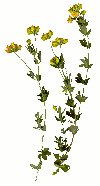
Grass hay
Grass hay commonly consists of one or more of the following grasses: timothy, bromegrass, orchard grass, reed canary, perennial rye, Canada or Kentucky bluegrass and fescue.
Most of the grasses grown in Ontario produce a seed head early in the season, before the time that the weather is reliable enough to cure hay. Therefore, by haying time, their nutrient content will have decreased to the 9-12% crude protein range, or lower, on a dry matter basis. For the grasses to be harvested at their highest nutrient content, for example, 20-22% protein, they would have to be cut very early in the season before the seed head has emerged from the boot stage. This is often when the weather can't be relied upon to make good hay.
Timothy is the traditional grass of horses and is recognized by its spike-like panicle. Timothy is easy to establish and cures easily. Bromegrass is a tall grass which grows readily on well drained soils. It is difficult to plant because of its large, light, fluffy seed which causes difficulties with many seeders. The tall fescues have fibrous root systems which are good for high traffic areas. Tall fescues can contain a seed-borne fungus (endophyte) which can extend the gestation length of pregnant mares. This will result in delayed births and dead, weak or dying foals. The bluegrasses have shallow root development and, therefore, have poor growth in the hotter parts of the summer. However, they create a good sod that will withstand heavy traffic.
Common pasture grasses
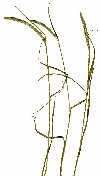
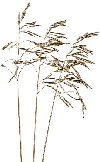
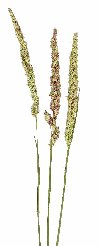
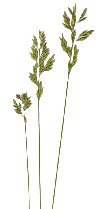
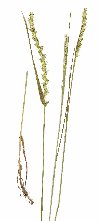
What hay growers should know
Hay growers have been taught to harvest hay in the early flower stage to obtain high protein/energy hay. There is little concern whether the hay has been rained on a bit since the aim is for hay with the highest protein /energy content. This is completely opposite to the horse owner who equates hay that has been rained upon with dust.
Most horses don't require hay with a high protein content. Horse hay can be harvested later in the haying season when the plants are in full flower. This will result in a higher yield of dry matter but the hay will be lower in protein and energy. The later harvesting will give the farmer some flexibility in haying and, hopefully, less chance of being rained upon. Horse hay must not have been rained upon.
Hay producers should get to know their clients' wants and needs. Take an interest in the client's horses and their needs. There will always be a market for small square bales of quality hay as most horse owners do not have the equipment to handle large round or square bales. However, there may be opportunities to provide a service of delivering large bales directly into feeders on a weekly basis.
What the horse owner needs to know
Horse owners determine quality of hay by: freedom from dust, green in colour, freedom from weeds and being able to recognize timothy spikes. These are not good indicators of quality. Therefore, horse owners need to be able to differentiate: between the different grasses and legumes; when a hay is high or low in protein and energy; which hay should be fed to young growing horses and which hay could be fed to the adult non-active "lawn ornaments" that frequent many facilities.
Nutrient content is more precisely measured by laboratory analysis. A balanced ration recommendation can be prepared to meet the individual horse's needs. Sample bags, hay core sampler and sampling instructions can be provided by your regional agricultural extension office or feed company representative. Interpretation of the result can be provided by your veterinarian, feed dealer or agricultural representative.
Freedom from weeds and poisonous plants is usually not a problem when hay is harvested from fields which have been cultivated regularly. However, on marginal or low fertility lands, plants such as ferns and horse tail can take over and pose a problem. The Ontario Ministry of Agriculture and Foods' Publication 505, Ontario Weeds, is an excellent reference for identifying weeds. Factsheets on poisonous weeds are available from the regional offices of the Ontario Ministry of Agriculture and Food.
References
- Wright R., Cation J., 1996 Ontario Horse Industry Study, Ontario Ministry of Agriculture and Food.
- Robinson S., Clare S., Leahy M., Pasture Production, Ontario Ministry of Agriculture and Food, Pub. 19.